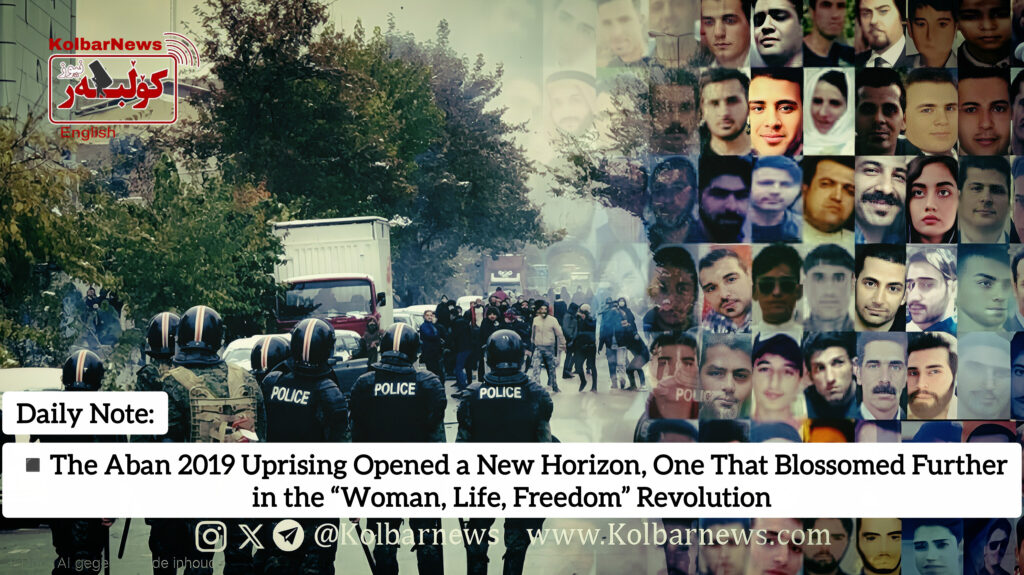
We are approaching the anniversary of the revolutionary Aban (November) uprising. On the evening of November 14, 2019 (Aban 23, 1398), the sudden and simultaneous increase in gasoline prices was announced a decision implemented from the early hours of the next day, sparking a wave of nationwide protests. The peak of the uprising occurred on November 16 and 17. The nationwide internet shutdown, the heavy presence of security forces, and the use of live ammunition and in some cases even heavy weaponry painted a shocking picture of the regime’s confrontation with protesting citizens. The exact number of those killed has never been released; officials admitted to “a few hundred,” while Reuters, citing internal sources, reported an estimated 1,500 deaths. Thousands more were arrested, and many still struggle with the legal and psychological consequences of those days.
Yet what unfolded in the final week of Aban 1398 was not a sudden, baseless eruption. It was the explosion of four decades of accumulated anger. Economic crisis, soaring inflation, the collapse of the rial, the shrinking purchasing power of workers and salaried employees, corruption and cronyism, and the public’s deep distrust of the regime’s empty promises all had, over years, created the conditions for a social explosion. Repeated labor protests, the demands of teachers and pensioners, student mobilizations, and the visible presence of women all testified to the buildup of unanswered demands.
The Aban 2019 uprising resounded across more than 190 cities and towns in 29 provinces, shaking hundreds of locations across the country. The backbone of the uprising was the urban poor, unemployed youth, and marginalized communities, but its echoes were heard among workers, students, and many other social groups. Acts of mutual aid, from helping one another in the streets to hiding and treating the wounded, revealed a society that had crossed the threshold of fear and entered a new realm of collective courage.
While the urban poor and marginalized youth formed the primary force of the uprising, its impact quickly reached other layers of society. Aban brought the impoverished and unemployed youth of both large and small cities into simultaneous motion. Notably, the cities of Kurdistan and Khuzestan somewhat distant from the nationwide protests of the December 2017 uprising were at the forefront from the very beginning in Aban 2019. The working people of Kurdistan demonstrated socially that their path to liberation from the grip of the Islamic Republic lies in solidarity with the nationwide revolutionary movement to overthrow the regime.
The Aban 2019 uprising, as a massive political movement, raised the ceiling of public demands and brought political and social struggle from the margins to the center. It sowed the seeds of neighborhood-level social networks an asset that later proved vital during critical junctures, especially in the 2022 revolutionary uprising of “Woman, Life, Freedom.” Aban 2019 paved the way for the flourishing of the Jina Amini Revolution in 2022. That revolution, drawing on a chain of prior experiences from street organization to personal bravery, from powerful symbolic acts to legal activism, transformed society, exposed the inefficiency of repression, and created a new balance of power. The de facto removal of compulsory hijab and the deepening internal fractures of the ruling establishment are signs of this new balance. Although the government has attempted to turn back the clock through renewed waves of repression and executions, these measures cannot reverse the changed political reality within Iranian society. If Aban 2019 highlighted the horizon of the Islamic Republic’s downfall, the 2022 uprising globalized that horizon through the emancipatory and universal language of “Woman, Life, Freedom.”
However, despite its magnitude, sacrifices, and achievements, the Aban uprising subsided after one week. One decisive gap was the insufficient connection between street protests and nationwide strikes in industrial and service sectors, a connection capable of disabling the machinery of repression and tipping the balance of power in favor of the oppressed and exploited. Workers in factories and major industrial complexes, who through their repeated struggles had helped cultivate the conditions for the uprising were not yet prepared to join the revolt with coordinated, nationwide strikes that could paralyze the regime’s repressive apparatus and pave the way for political general strikes. This was one of the weaknesses of the mass uprising; in reality, Aban 2019 had brought only a fraction of its full potential into the field and was not yet ready for the final battle.
The executioners of the Islamic Republic through the killing of more than 1,500 people, and the wounding, arrest, and imprisonment of thousands forced the revolutionary movement into retreat. The uprising revealed that street courage, without lasting connections to nationwide strikes and local networks, can be exhausted.
Yet Aban 2019, with all its costs and wounds, opened new horizons for Iranian society horizons that blossomed even more fully in the “Woman, Life, Freedom” uprising. Today, commemorating Aban 2019 means standing with the bereaved families, insisting on justice, and building collective structures for organization, solidarity, and a transition toward a system in which people govern their own destinies and live in security, freedom, equality, and dignity.
